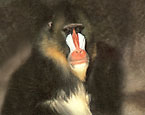|
Mandrill
(Mandrillus sphinx) #63-310 |
||||
|
|
Physical
characteristics and distribution
|
|
Mandrill
Mandrillus sphinx Home
ranges are relatively large, spanning 40-50 sq km. Social groups
are comprised of 1 adult males, 5-10 adult females and an average
of 10 juveniles. These smaller groups some together in the dry
season, resulting in troops of as many as 200 individuals. Adult
males without harems are solitary. Reproduction appears to be
seasonal with most births occurring between the months of January
and April in the population studied in Gabon. Gestation is 168-176
days. |
|
Description
of the brain
|
|
Animal
source and preparation
|
|
All
specimens collected followed the same preparation
and histological procedure.
|
Other Related Resources (websites and publications)
List of Specimens | Explore Collections | Brain Sections | Brain Evolution | Brain Development | Brain Circuitry | Brain Functions | Location and Use | Related Web Sites | Contact Us | Search MSU Database | Personnel | Home


